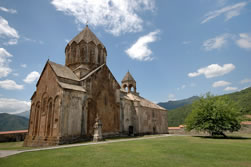Cathedral of St. John the Baptist

Gandzasar’s Cathedral of St. John the Baptist from north-west.
Gandzasar’s most important structure is the imposing Cathedral of St. Hovhannes Mkrtich (Armenian:
Սբ. Հովհաննես Մկրտիչ, meaning “Saint John the Baptist”). It is a large church with a cupola in the inscribed cross plan. The Cathedral was built between 1216 and 1238, and has been hailed as a “crown jewel” and the “encyclopedia” of Armenian architecture by the famous Russian scholar Anatoly. L. Yakobson of St. Petersburg’s Hermitage. [1] Professor Charles Diehl (1859-1944) of the Sorbonne University, the renowned French art historian and specialist on Byzantium, placed Gandzasar in a group of five most important examples of Armenian monumental art which belong to the world’s architectural masterpieces. [2]
Diehl’s other four Armenian masterworks included: Cathedral of the Holy Cross on the Lake Van’s Akhtamar Island (915-921), Temple of Saint Hripsime in Vagharshapat
(completed in 618), Monastery of Haghbat (founded in the 10th century) and Cathedral of the Holy Savior in the city of Ani (completed in 1001).
The Cathedral of Saint John the Baptist of the Gandzasar Monastery closely resembles Armenia’s two other churches: Cathedral of the Holy Mother of God of the Harich Monastery in Armenia’s present-day province of Shirak, and Cathedral of Saint John the Baptist of the Hovhannavank Monastery located in the province of Aragatzotn.
Foundation of the Cathedral
The foundations of the Cathedral were laid in 1216 by Prince Hasan Jalal Vahtangian the Magnificent, who called himself the “Supreme Potentate” of Artsakh’s largest and strongest Principality of Khachen. As described by the historian Kirakos Gandzaketsi—who was Hasan Jalal’s contemporary and, most likely, knew him personally—the Cathedral was completed in 1238 and sanctified on the day of the Feast of Vardavar (Armenia:
Վարդավառ; Transfiguration of Christ, July 22), in the year 1240. The consecration of the church took place in the presence of over 700 guests, who included His Holiness Nerses, Katholicos of Aghvank (patriarch of Armenia’s eastern lands), the famous medieval scholar Vanakan Vardapet (1181-1251), as well as Armenian bishops from all over Armenia. The sanctification of the Cathedral was delayed by two years because of the Mongol invasion of Armenia. [3]
The same information can be inferred from inscriptions in Armenian found on the walls of the Cathedral, including a large dedication made by the order of Hasan Jalal
himself on the interior of the Cathedral’s western wall. The main part of the inscription reads:
“In the name of the Holy Trinity, Father, Son and the Holy Spirit, I, Jalal Dola Hasan, servant of God, son of Vahtang, grandson of Hasan the Great, the native potentate of the high and broad province of Artsakh, King of Hohanaberd, with large districts, have ordered to inscribe these lines. Father of mine, before his departure from this world, ordered me and my mother Khorishah, daughter of Sargis the Great, Prince of Princes, to erect a church and [organize] the cemetery of our forefathers in Gandzasar, building of which began in the year 765 of the Armenian Calendar (1216) with the help of the Grantor of Benefits (God); and when we erected the wall above the windows, mother of mine abandoned secular life and departed for pilgrimage to Jerusalem for the third time, where, putting on the cilice and spending many years in reclusion near the Lord’s Temple, passed away on the day of the Holy Resurrection of Christ, and there was laid to rest. As to us, we, being aware of the danger of being idle, hurried to complete the construction work with the holy blessing of Merciful God, in the year 787 (1238)...” (Source: Bishop Makar Barkhudarian. Artsakh. Baku, 1885, Chapter: Gandzasar Monastery, p. 111)
Overall, the monastery’s structures contain up to 200 texts inscribed in Old Armenian in different times.
Architecture of the Cathedral
Armenian architecture blossomed during the post-Seljuk period and the beginning of the Mongol period (late twelfth and
thirteenth centuries). Monasteries in this era served as active centers of art and scholarship. Most of them contained scriptoria where manuscripts were copied and illuminated. They also were fortified, and often served as places of refuge for the population in times of trouble.
Several monastic churches in Artsakh from this period adopted the model used most widely throughout Armenia: a cathedral with a cupola in the inscribed cross plan with two or four angular chambers. Examples include the three largest and most complex monasteries of Artsakh: Dadivank (1214-1237), Gandzasar (1216-1261) and Gtichavank (1241-1246).
Several ancillary buildings as well as memorials in the courtyard testify to a more ancient origin of the monastery. These include several khachkars (unique-to-Armenia stone monuments with engraved crosses). Evidently, the original church of the Gandzasar Monastery was a modest structure that did not support the new ambitions and prestige of the rising Lords of Khachen. Hence, it was demolished in 1216, in the course of the expansion and remodeling of the monastery. But some medieval Armenian historians, such as Yeremia Chelebi (in his “Chronicles”) and others, noted that the original Gandzasar Monastery was established most likely by Armenia’s foremost saint—St. Gregory the Enlightener, in the 4th century.
The design of Gandzasar’s Cathedral of Saint John the Baptist is based on an architectural composition developed in the 10th century and well represented in other ecclesiastical ensembles located throughout the present-day Republic of Armenia, such as Haghbat (967-991), Sanahin (967-1084) and Kecharis (1033-1214). The monastic complexes of the 12th-13th centuries adhered fully to that blueprint, as testified by main churches at the Harichavank (1201), Hovhannavank (1216), and Geghard (1215) monasteries, in various parts of modern Armenia. [4]
Gandzasar’s 16-piece colonnade on the drum is effectively a copy of that of Harichavank, and the great cross at the top of the facade is also found at Kecharis and Hovhannavank.
A conspicuous characteristic of Armenian monastic architecture of the thirteenth century is the gavit (also called zhamatoun; Armenian:
գավիթ ժամատուն). The gavits are special square halls usually attached to the western entrance of churches. They were very popular in monastic complexes where they served as narthexes, assembly rooms and lecture halls, as well as vestibules for receiving pilgrims. [5]
The gavit at Gandzasar is distinctive for its size and superior quality of workmanship. According to Kirakos Gandzaketsi, it was built by Hasan Jalal’s wife Mamkan (the inscription on the masonry says: Mamkan, Hasan and their son, Atabak) in 1261, a year after Hasan Jalal’s martyrdom in Persia at the hands of the Mongols.
The gavit was completed in 1266. [6]
The gavit’s layout in Gandzasar corresponds exactly to that of Haghbat and Mshkavank, two monasteries located in the northern part of today’s Republic of Armenia. The ceiling is illuminated by a central window which is adorned with the same stalactite ornaments as in the Armenia’s monasteries of Geghard and Harichavank. [7]
In the case of the Gandzasar and Gtichavank monasteries, the cone over the cupola is umbrella-shaped, a picturesque design that was originally developed by the architects of Armenia’s former capital city of Ani, in the tenth century, and subsequently spread to other provinces of the country, including Artsakh. [8] Umbrella-shaped domes were first introduced in the 10th century. [9] First examples where this feature was used include the Church of the Holy Virgin at Amberd Fortress and Church of St. Stephanos of the Marmashen Monastery. However, most closely Gandzasar’s dome resembles the domes on the Cathedral of the Holy Mother of God of the Harichavank Monastery, and the Cathedral of Saint John the Baptist of the Hovhannavank Monastery. Both churches were erected almost simultaneously with Gandzasar’s Cathedral. [10]
Some late medieval Armenian churches were evidently inspired by Gandzasar’s characteristic dome. One of them is the renowned Cathedral of the St. Stephanos Monastery, built in the 17th century; it is located in northern, where the borders of Armenia, and Nakhichevan (Azerbaijan) meet.
The exclusively rich decorative pattern of the interior and exterior renders a particular uniqueness to Gandzasar’s Cathedral. After the Akhtamar Cathedral of St. Cross on the Lake Van (now in Turkey), Gandzasar contains the largest amount of sculpted decor compared to other architectural ensembles of Armenia. The most famous of Gandzasar’s bas-reliefs that embellish its domes and walls are Adam and Eve, Jesus Christ, a group of stylized animals (Lions, Eagles and Bulls—symbols of the Vahtangian princes to whom Hasan Jalal belonged), and two Churchwardens holding on their hands miniature models of the cathedral. [11]
Another sculptural work is a large Crucifix under the gable of the Western facade. The composition is made up of a broad-beamed cross with the figure of Christ in its lower half. With seraphs depicted overhead, there are the kneeling figures of the Holy Virgin and John the Baptist whose hands are outstretched to the suffering Christ.
Another large relief of the Cross is on the northern facade of the Cathedral. This repeats design found on main churches in the monasteries of Harichavank, Kecharis, and Hovhannavank—in western and central regions of modern Armenia. The Cross rests on a large protuberant arch, with an ornamented window and a small relief of the Armenian sign of the Sun (which is customarily found in lower parts of Armenia’s famous stone monuments with engraved Cross called khachkars).
Tomb of Hasan Jalal Vahtangian and Other Memorials
The monastery serves as a burial site for Hasan Jalal Vahtangian and other Khachen princes and bishops of his lineage. The tomb of Hasan Jalal is located in front
of the entrance to the main chamber of the cathedral, in the gavit.
The tombstone is carved from a solid piece of white marble. It is decorated with three large circular carvings: the Hexagram (“Star”) of David, a Biblical symbol, which contains in its center an image of a swirl-styled Wheel of Eternity, an ancient Indo-Aryan sign used widely by medieval Armenians; the Wheel is supported by six pieces of vegetable decor, two of which represent fleur-de-lis (French lilies). This curious compound ornament is found in some other parts of historical Armenia where princely families related to Hasan Jalal’s Arranshahik clan held power. This includes the Tsaghats-Kar Monastery in Vayots Dzor—the domain of the princely clans of Orbelian and Proshian (the latter were descendents of the Hahbakian dukes from Artsakh).
The second circle is organized as a 16-beam star. It is not entirely clear what it represents but it looks like a combination of the East Asian version of the
Wheel of Eternity (such as India’s Ashoka Chakra) and Macedonia’s 16-ray Star of Vergina.
The third circle is what is known in Armenian art history as the “Sun” (Armenian:
արև) an ornamented and, sometimes, protuberant sphere commonly found in the lower parts of khachkars (unique-to-Armenia stone monuments with large carving of a Christian cross). The Sun is thought to be one of the rudiments of the ancient sun-worshipping creed preserved in
Armenia’s Christian art.
The tombstone contains the following inscription in Armenian:
"ԱՅՍ է ՀԱՆԳԻՍՏ ՄԵԾԻՆ ՋԱԼԱԼԻՆ: ԱՂԱԻԹՍ ՅԻՇԵՑԵՔ։ ԹՎ ՊՁ.
It reads: “Here Rests the Great Jalal; Remember Him In Your Prayers; Year 1431.”
The tomb of Hasan Jalal is flanked by two groups of tombstones, all belonging to top hierarchs of the Holy See of Gandzasar. On the left side, one can find the tombstones of Katholikos Yeremia Hasan-Jalalian (reigned from 1676-1700) and of Katholikos Yesai Hasan-Jalalian (reigned from 1702-1728)—a historian and a prominent
leader of the Armenian national liberation movement of the 1720s. On the right side, there are two other plates: of Katholikos Hovhannes Gandzasaretsi (reigned from 1763-1786) and Sargis Gandzasaretsi (reigned from 1810-1828)—the last patriarch of Gandzasar with the full title of Katholikos. Near them is the gravestone of Metropolitan Baghdasar Hasan-Jalalian (lived 1775-1854), a clerical leader who played a critical role in organizing the Karabakh Diocese of the Armenian Apostolic Church. Inscriptions on all of these tombstones begin and end with the same two phrases that highlight the connection of the buried to Hasan Jalal Vahtangian: “Here is the grave of … [who belongs] to the dynasty of [Hasan] Jalal Dola.” Also in the gavit there are older tombstones: of Katholikos Davit, Katholikos Grigor and Katholikos Hovhannes.
The Cathedral of St. John the Baptist’s courtyard has a number of other memorials including numerous khachkars—unique-to-Armenia stone crosses. Near the northern wall of the Cathedral stands a large khachkar commemorating Hasan Jalal Vahtangian’s daughter Hatun, whose mother and Hasan Jalal’s wife, Mamkan, was the daughter of the last ruler of Artsakh’s southern Kingdom of Baghk. An inscription in the lower part of the khachkar reads: “I, Hasan, son of Vahtang, erected this cross [in memory of] my daughter Hatun, and on behalf of her mother, the Queen—daughter of the King of Baghk.” [12]
Ancillary Buildings
Besides the Cathedral and the gavit, the monastery includes several monastic dormitories, a hermitage with eight solitary cells, a refectory, and several utility structures. Adjacent to the eastern wall is the building of Gandzasar’s Seminary that was expanded in 1898. The courtyard covers the area of approximately two acres. [13]
The monastic complex includes offices of the Katholicosate of Aghvank and the Reception Hall built in the eighteenth century by Katholikos Yeremia Hasan-Jalalian.
All of Gandzasar’s buildings are surrounded by high vine-covered stone walls, with two arched entrances. The main entrance looks toward the Castle of Hohanaberd and the cemetery, and the rear entrance leads to the town of Vank that lies at the foothills of Mount Gandzasar.
History of Renovation
The first recorded renovation of the monastery was undertaken in 1551 by Katholicos Sargis, who left a memorial inscription on one of the walls of the Cathedral, and on the pages of a Gospel produced at Gandzasar’s scriptorium at the time. Another repair effort was made in 1781 by Abov the Centurion, a military commander and son of Melik Hovsep of Talish, the Armenian ruler of Artsakh’s northern country of Gyulistan. Gandzasar was again repaired in 1907, by orders of Abraham-bek Hasan-Jalalian, a successor of hereditary rulers of the Principality if Khachen. [14] And, in 1999-2002, the monastery underwent profound renovation financed by Mr. Levon Airapetian, a wealthy Russia-based businessman and benefactor who is related to the Hasan-Jalalian family (he is one of Abraham-Bek Hasan-Jalalian’s great-grandsons).















